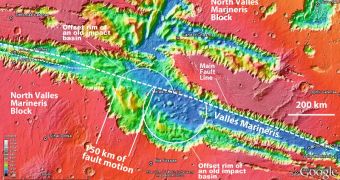A researcher at the University of California in Los Angeles (UCLA) says that he found concrete evidences suggesting that Mars still has active plate tectonics. Previously, scientists believed that Earth is the only planet in the solar system capable of sustaining such processes.
Plate tectonics occur when heat generated by a planet's interior drives molten magma above the core, known as the mantle, into swirling motions. The process forces the crust, the uppermost layer of a planet, to break apart into chunks called tectonic plates, which then collide with each other.
The most important requisite for plate tectonics to exist is a spinning core, capable of producing motions in the mantle. For years, scientists believed that Mars was a dead world, whose core has long since stopped moving.
This theory was made stronger by the fact that missions to the Red Planet thus far failed to discover a magnetosphere, the layer of the atmosphere responsible for deflecting harmful radiations from the Sun and outer space. On Earth, life in its current form would be impossible without such a shield.
The new discovery, made by UCLA professor of Earth and space sciences An Yin, has far-reaching implications. The research appears as the cover story of the August issue of the journal Lithosphere. Yin was the sole author of the investigation.
In order to make the discovery, Yin, a planetary geology expert, used data from the Thermal Emission Imaging System (THMIS) instrument aboard the Mars Odyssey spacecraft, and from the High Resolution Imaging Science Experiment (HiRISE) instrument on the Mars Reconnaissance Orbiter.
Of the 100+ satellite images he analyzed, the expert was able to identify signs of plate tectonics in about 12 of them. He was able to find the signs drawing on his experience from studying fault lines here on Earth, such as the one under the Himalayas and Tibet.
“Mars is at a primitive stage of plate tectonics. It gives us a glimpse of how the early Earth may have looked and may help us understand how plate tectonics began on Earth,” An Yin says of the study.
“When I studied the satellite images from Mars, many of the features looked very much like fault systems I have seen in the Himalayas and Tibet, and in California as well, including the geomorphology,” the expert adds.
Other research teams will soon pick up this line of study, seeking to confirm or deny the discovery. If these results turn out to be true, then planetary scientists will be left to answer a much more difficult question – if the Martian core still spins, then why is there no magnetosphere protecting the planet?

 14 DAY TRIAL //
14 DAY TRIAL //